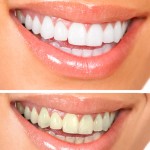
Tooth whitening or bleaching is growing in popularity and can be performed by a dentist using high concentrations of hydrogen peroxide or can be applied by the patient at-home using low concentrations of carbamide and hydrogen peroxides.
The aim of the study was to compare the color change produced by tray-delivered carbamide peroxide (CP) versus hydrogen peroxide products (HP) for at-home bleaching
Methods
Searches were conducted in the Medline, Scopus, Web of Science, Latin American and Caribbean Health Sciences Literature database (LILACS), Brazilian Library in Dentistry (BBO), Cochrane Library, Current Controlled Trials (www.controlled-trials. com), International Clinical trials registry platform (http:// apps.who.int/trialsearch/), the ClinicalTrials.gov (www.clinicaltrials.gov), Rebec (www.rebec.gov.br), and EU Clinical Trials Register (https://www.clinicaltrialsregister.eu) databases with no data or language restrictions. Randomised clinical trials that compared tray-delivered CP versus HP for at-home dental bleaching were considered.
Two reviewers selected studies and abstracted data with study quality being assessed independently by two reviewers using the Cochrane risk of bias tool. The primary outcomes were color change in shade guide units (SGU) and ΔE with tooth sensitivity and gingival irritation as secondary outcomes. Standardised mean differences and 95% confidence intervals (CI) were calculated to summarise colour change and risk ratios (RR) for tooth sensitivity and gingival irritation
Results
- 13 studies involving a total of 774 patients were included.
- 5 were considered to be at high risk of bias.
- 8 used a VITA shade guide for colour evaluation with 4 also using either a spectrophotometer or colorimeter for colour assessment with 4 studies used digital image analysis with 1 study employing a fluorosis scale.
- Sample sizes in the studies ranged from 16-114 patients.
- 9 studies used HP strips, 4 HP in trays, concentrations varied from 2.5 to 14% with 7.5% being the most common.
- CP gel concentrations varies from 5-35% with most using 10%.
- Treatment periods ranged from 2-28 days, 14 days being the commonest.
- 8 ‘low-risk’ studies contributed to the meta-analysis
- For ΔE, the standardized mean difference was -0.45 (95 % CI -0.69 to -0.21), which favored tray-delivered CP products (p < 0.001).
- The color change in ΔSGU (p = 0.70), tooth sensitivity (p = 0.83), and gingival irritation (p = 0.62) were not significantly different between groups.
Conclusions
The authors concluded:-
Tray-delivered CP gels showed a slightly better whitening efficacy than HP-based products when the color change was evaluated with a spectrophotometer; such superiority, however, could not be detected with shade guide units. Both whitening systems demonstrated equal level of gingival irritation and tooth sensitivity.
Comments
The authors have searched a wide range of databases for this review and have only included randomized controlled studies. An earlier systematic review by Serraglio et al (Dental Elf 14th Aug 2015) compared the efficacy and safety of over-the-counter whitening strips to the ADA-recommended home-bleaching technique using 10% carbamide peroxide gel. The Serraglio review included 9 studies compared with the 13 included in this new review although only 8 have been used in the meta-analysis. The studies included in both reviews demonstrate a high degree of heterogeneity with variation in concentration of the bleaching agents, and application periods. The Serraglio review suggest no difference between the two approach while this new review suggests a slightly greater benefit from the tray based systems. Serraglio also suggested higher sensitivity with tray bases systems while this new review suggests no difference in adverse effects.
Overall thought the available studies are small and heterogeneous with a majority being funded by manufacturers and short term. So as a 2006 Cochrane review by Hasson et al noted:-
There is a need for pragmatic long-term and independent clinical studies that include participants representing diverse populations. There is also a need to evaluate long-term harms.
It is important to note that a wide range of home whitening kits are available and the concentrations of whitening agents also vary. Regulations regarding the sale of these products also varies from country to country.
Links
Primary paper
Luque-Martinez I, Reis A, Schroeder M, Muñoz MA, Loguercio AD, Masterson D, Maia LC. Comparison of efficacy of tray-delivered carbamide and hydrogen peroxide for at-home bleaching: a systematic review and meta-analysis. Clin Oral Investig. 2016 Jun 11. [Epub ahead of print] Review. PubMed PMID: 27290611.
Other references
Original review protocol on PROSPERO
Dental Elf 14th Aug 2015
Dental Elf 28th Jul 2015
Hasson H, Ismail A, Neiva G. Home-based chemically-induced whitening of teeth in adults. Cochrane Database of Systematic Reviews 2006, Issue 4. Art. No.: CD006202. DOI: 10.1002/14651858.CD006202.

Tooth whitening: Tray-delivered gels show a slightly better whitening efficacy? https://t.co/AYhplpIETk
[…] post Tooth whitening: Tray-delivered gels showed a slightly better whitening efficacy appeared first on […]
Tooth whitening: Tray-delivered gels showed a slightly better whitening efficacy https://t.co/AYhplpIETk
Review suggests slightly better tooth whitening efficacy with tray-delivered carbamide peroxide gels https://t.co/AYhplpIETk
Tray-delivered gels showed a slightly better tooth whitening efficacy https://t.co/AYhplpIETk
Better tooth whitening efficacy with tray-delivered carbamide peroxide gels suggests review https://t.co/AYhplpIETk
Don’t miss- Tooth whitening: Tray-delivered gels showed a slightly better whitening efficacy https://t.co/AYhplpIETk